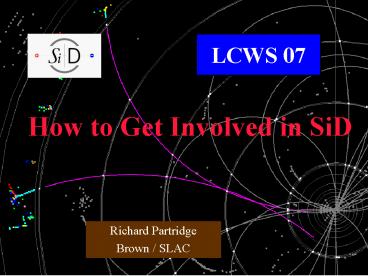How to Get Involved in SiD - PowerPoint PPT Presentation
1 / 15
Title:
How to Get Involved in SiD
Description:
Hard to imagine the ILC can be approved without this. SiD will be ... Energy, polarimeter design. Beam pipe design. Forward Det. Contacts: Bill Morse (Forward) ... – PowerPoint PPT presentation
Number of Views:50
Avg rating:3.0/5.0
Title: How to Get Involved in SiD
1
How to Get Involved in SiD
LCWS 07
- Richard Partridge
- Brown / SLAC
2
Why Get Involved in SiD Now?
- During the next 3 years, it is imperative for
the ILC community to develop two optimized,
complementary, and well understood detector
designs that demonstrate the ability to carry out
a compelling physics program - Hard to imagine the ILC can be approved without
this - SiD will be one of these two detectors
- The precision, speed, and robustness of silicon
detectors is unmatched by the competing
technologies - You can make a significant contribution in
shaping the SiD detector design - The software tools needed for optimizing the
detector design are either in place or well
advanced, but the process of using these tools to
optimize the detector design has barely started - An active detector RD program is essential to
make informed technical choices, develop detailed
detector designs, and demonstrate the feasibility
of these designs through simulations, prototypes,
and test beam studies
3
How to Get Involved in SiD
- A 3 step program for getting involved in SiD
- Identify an area in SiD where you would like to
contribute - Talk with SiD leadership about your interests and
our needs - Start attending meetings and begin contributing
to SiD
4
A Tour of SiD for Higgs Bosons
- A comprehensive program of precision measurements
of Higgs Boson properties is a key reason for
building the ILC - Since Higgs Bosons are known to be a demanding
lot, they place many requirements on detector
performance - Focus on 3 Higgs Boson measurements to illustrate
how our physics goals impact detector design and
provide opportunities for you to contribute to
SiD - Branching ratios
- Search for invisible Higgs decays
- Triple Higgs coupling
5
Higgs Branching Ratio
- The Standard Model (and many beyond the Standard
Models) account for particle masses through
couplings to one or more Higgs Bosons - Couplings are proportional to m2
- We can test this hypothesis by measuring the
branching ratios of the Higgs to all accessible
final states - Particularly challenging to separate bb, cc, and
gg decay modes requires excellent vertex
detector performance
6
Vertex Detector Projects
- Pixel sensor development and testing
- Mechanical design and testing
- Power delivery and signal transmission
- Vertex and flavor tagging algorithms
- Test beam program
Vertex Contacts Su Dong sudong_at_slac.stanford.edu
Ron Lipton lipton_at_fnal.gov Bill Cooper
(mechanics) cooper_at_fnal.gov
7
Search for Invisible Higgs Decays
- Look at ZH production with Z? mm-
- Higgs events can be identified in the Z recoil
mass - Measurement makes no assumptions about Higgs
decay, so sensitive to invisible and non-SM
decays - Sharpness of the recoil mass peak depends on
tracker momentum resolution
8
Tracker Projects
Tracker Contacts Marcel Demarteau demarteau_at_fnal.
gov Rich Partridge partridge_at_hep.brown.edu Bill
Cooper (mechanics) cooper_at_fnal.gov
- Module design and testing
- Mechanical design and testing
- Alignment and vibration measurement
- Forward tracker design
- Tracking algorithms and optimization
- Test beam program
9
Triple Higgs Coupling
- Triple Higgs coupling is a consequence of the f4
term in the Higgs potential - SM makes a precise prediction for this coupling
- SiD can measure the triple Higgs coupling in the
ZHH channel - Small cross section will need to use multijet
final states like qqbbbb - Need good calorimeter performance to identify
Higgs mass peaks
10
Calorimeter Projects
- ECal design and testing
- HCal design and testing
- Mechanical Design
- PFA development and studies
- Other Simulation studies t, p0, l, etc.
- Test beam program
Calorimeter Contacts Ray Frey (ECal) rayfrey_at_cosm
ic.uoregon.edu David Strom (ECal) strom_at_physics.uo
regon.edu Jerry Blazey (HCal) gblazey_at_nicadd.niu.e
du Harry Weerts (HCal) weerts_at_anl.gov Norman Graf
(PFA) ngraf_at_slac.stanford.edu Steve Magill
(PFA) srm_at_anl.gov
11
Muon and Solenoid Projects
- Muon system design
- Muon tracking algorithms and studies
- Punch-through, background studies
- Test beam program
- Solenoid design
Muon/Solenoid Contacts Henry Band
(muon) hrb_at_slac.stanford.edu Gene Fisk
(muon) hefisk_at_fnal.gov Paul Karchin
(muon) karchin_at_physics.wayne.edu Kurt Krempetz
(solenoid) krempetz_at_fnal.gov
12
Forward Detector and MDI Projects
- LumCal, BeamCal, GamCal design
- MDI design
- Energy, polarimeter design
- Beam pipe design
Forward Det. Contacts Bill Morse
(Forward) morse_at_bnl.gov Phil Burrows
(MDI) p.burrows_at_qmul.ac.uk Tom Markiewicz
(MDI) twmark_at_slac.stanford.edu Tauchi Toshiaki
(MDI) toshiaki.tauchi_at_kek.jp
13
Benchmarking Projects
- Physics performance studies
Benchmarking Contacts Tim Barklow timb_at_slac.stanf
ord.edu Aurelio Juste juste_at_fnal.gov
14
Simulation Projects
- Detailed detector simulation
- Algorithm development and detector optimization
through simulation
Simulation Contact Norman Graf ngraf_at_slac.stanfor
d.edu
15
Summary
- It is a great time to get involved in SiD
- Many interesting projects that need your help
- More information can be found in the SiD talks in
LCWS - Getting started is easy
- Identify an area in SiD where you would like to
contribute - Talk with SiD leadership about your interests and
our needs - Start attending meetings and begin contributing
to SiD - See the SiD web page for links to further
information - http//www-sid.slac.stanford.edu

